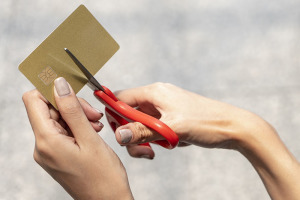Rabbit breeding as a business is becoming more and more popular in our country. Of course, before you start organizing a farm of this specialization, you need to not only familiarize yourself with the technology of breeding these animals, but also take care of buying the necessary equipment.
Benefits of Breeding Rabbits
Keeping rabbits is quite troublesome and complicated, as these animals are quite picky about their care. Animals are relatively easy to get sick, and with unbalanced feeding, they grow and breed poorly. However, using the right growing technology, such farms pay off very quickly. Rabbit meat on the market is very expensive (about 300-350 rubles per kilogram). It's all about its valuable dietary properties. Unlike meat of other farm animals, it does not contain cholesterol. Therefore, it is very useful for people suffering from cardiovascular diseases.
As for reproduction, only one uterus per year can bring 25-50 rabbits. After slaughtering this offspring, the entrepreneur has the opportunity to sell about a centner of such a valuable and expensive product as rabbit meat. That is, at its usual cost, you can get revenue of 30-35 thousand rubles. The queen bees in a household farm usually contain 3-4, and on a small farm - 10-20.
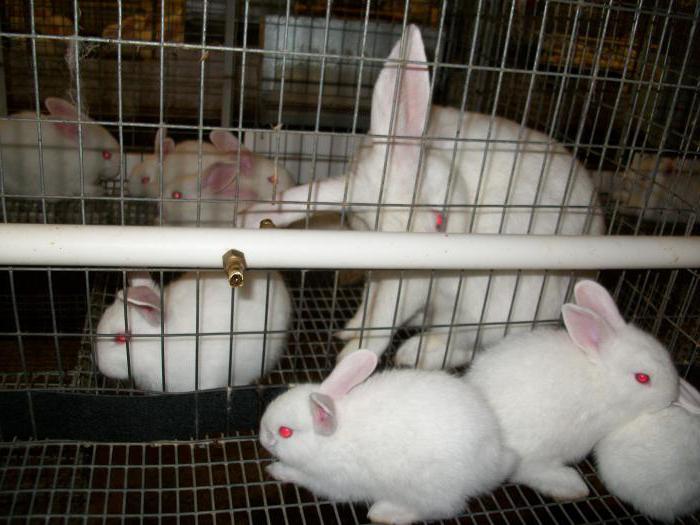
Necessary equipment
Rabbit farms are necessarily equipped with special equipment. Namely:
- cells or mini-rabbit farms;
- feeders;
- drinkers;
- struts for slaughter.
What else might you need?
To make skins, you will need a container - a longboat and special hangers - “rules”. On large farms, the list of necessary equipment may also include:
- containers and tapes for collection and transportation outside the litter farm;
- septic tanks for the disposal of urine.
If the cells are supposed to be installed indoors, it is also necessary to purchase ventilation equipment. Of course, rabbit farms should be well lit. Therefore, you also have to purchase lamps.

What should be the cells?
Since the skin of most breeds of these animals is very warm, they do not need a heated barn. Sometimes rabbit cages are installed right on the street. The choice of this basic equipment for the rabbit farm should be approached with all responsibility. When buying or making cells, you should adhere to these rules:
- the dimensions of the home for the rabbit must exceed its size by at least 4 times;
- the height of the cage should be such that the animal can sit unhindered in an upright position;
- for the cell floor, you should choose a mesh with a cell size of not more than 1x2.5 cm;
- cages for rabbits located on the street must be covered with some kind of roofing material;
- the minimum permissible height of the cage above ground or floor is 120 cm.
Street cells should be placed in the shade of trees or buildings. In this case, the animals will feel more comfortable in the summer, and, consequently, raising rabbits will be more successful. When choosing a place for cells, one must also take into account the prevailing wind direction in a given area. In addition to the usual ones, for the farm you will need to purchase special cells for the uterus. From simple they differ in the presence of two compartments.
One of them is intended for the rabbit, the other for brood.If desired, young animals can be kept in cages for adults (3-4 rabbits) or in enclosures (10-15 animals). The latter breeding method allows you to increase the speed of weight gain by animals and reduce the incidence. After all, rabbits are very mobile and active animals. Consequently, even in the most spacious cells, they can feel depressed and develop worse. However, when using the aviary method of keeping, special attention should be paid to protecting the animals from all kinds of domestic and wild predators.
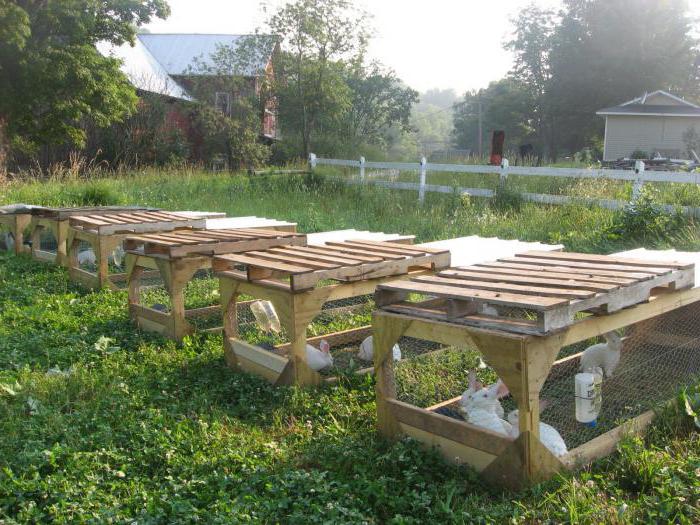
What do you need to know when making cells with your own hands?
In order to make a reliable home for rabbits, you should choose the right materials. A beam of 50x50 cm is suitable for the legs and frame of the cage. The side and back walls, as well as the roof, are usually made of plywood 10-15 mm. The mesh netting cannot be used for the manufacture of cells. When using this material, it is impossible to reliably protect rabbits from the attack of any animals. For cells, a special mesh is usually used with a wire thickness of 12-16 mm.
On a small farm, in the absence of the ability to install tape for litter, it is worth using trays. This design element of the cage can greatly facilitate the cleaning process.
Feeding troughs and drinking bowls
Inside the cage, equipment should be positioned so that the animal can easily reach it. Feeding troughs for animals such as breeding rabbits are made from easy-to-care material. Wood and plastic are usually not used for this purpose. The best option is thin tin. Before installing such a feeder in the cage, however, it must be ensured that it does not have sharp edges. Otherwise, the rabbit may injure the legs or, much worse, the nose. Bunker feeders can be made of slate, plexiglass and other similar materials. They are usually placed on the door of the cage. At the bottom of each feeder, two holes should be made for liquid drainage.
Between adjacent cells usually set up a small nursery under the hay (in the form of the letter V). It is best to make them from a mesh with a large cell. Both skinned and meat rabbits have very narrow muzzles, and therefore forage from such creches is easy to get. There will be no loss of hay as a result of trampling.
Drinking bowls for rabbits can be used nipple. In this case, they are installed outside the cells. Ordinary drinkers should be placed at a height of about 7-10 cm from the floor. Otherwise, rabbits will defecate in them.
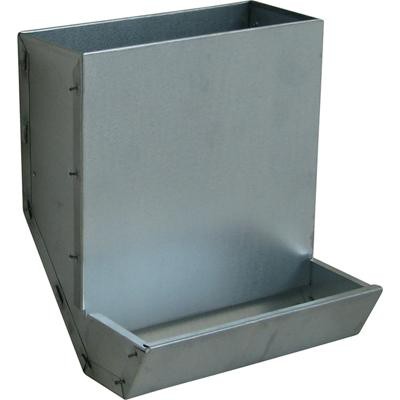
Equipment for slaughter and skinning
Growing rabbits for meat usually lasts up to the age of 5-6 months. After this, the animals are slaughtered, because keeping them further becomes irrational. Of course, the quality of the meat of these animals depends not only on the type of feed used, but also on how accurately the rules of slaughter are observed. In order for the carcass to be stored for a long time, blood must be drained from it. Therefore, after slaughter, it is suspended on a special strut, the skin is removed (by the principle of stocking) and the internal organs (everything except the liver) are removed. It is a spacer metal tube with two tips. It is usually attached to the base with a hook.
On large farms, other equipment is used for slaughter. Rabbits are killed in this case, usually using an electric silencer. This method is considered the most humane. The carcasses themselves are cut on a special line.
Features of keeping rabbits
Rabbits, breeding of which is a responsible and difficult occupation, animals are highly productive. But the animals will develop well both in a small household farm and on a large farm will only be subject to the following care principles:
- maintaining cleanliness in the cells and in the room in which they are installed;
- regular preventive measures to prevent epidemics;
- making a balanced diet.
Breeding rabbits are much faster than other farm animals are infected with various kinds of infectious diseases. That is why the cells can not be installed, for example, next to the chicken coop. Preventive measures to prevent the development of various diseases in animals consist mainly of preventive vaccinations. Shaking out the trays should be done at least once every two days. In the cells and rooms themselves, they carry out disinfection once a week. In this case, you can use either a special tool, or the usual "White".
Feeding rabbits
The diet of these animals should include both coarse (hay, twigs) feed, and succulent (root crops, grass) and concentrated (barley, oat crusher). With balanced feeding, the rabbit fur becomes thick and shiny, and the animal begins to grow very quickly. Wheat is usually not given to these animals. Grass is fed in large quantities. It is best if she will be in the cells all the time (in the manger). Adult rabbits can be given fresh grass, young animals can only be dried. Of course, you need to ensure that plants that are poisonous to these animals (celandine, nightshade, etc.) do not get into the cells.

The most useful root crop for rabbits is carrots. Beets are given, but not in too large quantities. The same goes for cabbage. Potatoes are fed boiled.
The supplier of crushers and bran for rabbits should be selected as carefully as possible. Do not purchase feed from dubious sellers. In most cases, the infectious diseases of these animals are transmitted precisely through the crusher.
Rabbits: farm breeding
The time of the first mating depends on the breed of animals. Most often, the rabbit is launched into the cage to the male at the age of 5 months. Two weeks later carry out a control mating. The rabbit uterus bears 28-32 days. Just before the round, she begins to build a nest. If farm staff noticed that the animal began to pluck down fluff on its chest, it means that offspring will appear soon and more hay should be put in the cage. From it, the uterus builds a nest, lining it with its down. The number of newborn rabbits also depends on this particular breed. In most cases, there are 6-8 in the litter. But there are breeds of rabbits, representatives of which can bring a larger number of cubs - up to 15-16 pcs.
Rabbits are born naked and completely helpless. They begin to move quite confidently only at the age of two weeks. A few days later, the cubs leave the nest and try to eat with the uterus from the feeder. A week after this, it is necessary to remove the nest with down from the cage and carry out disinfection. Bunnies are sown from the mother, usually at the age of 3.5 months.
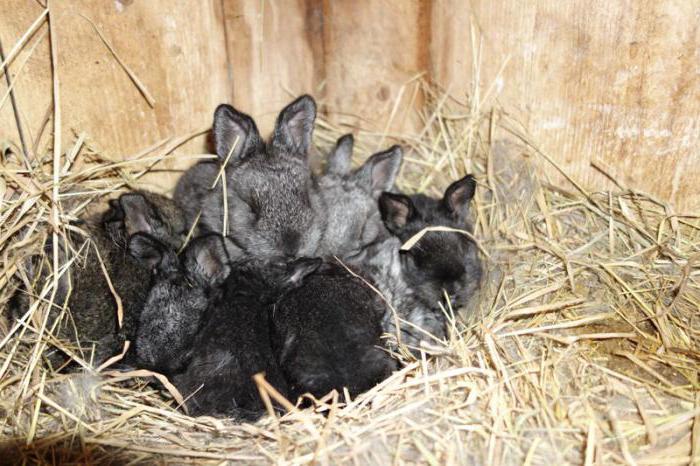
Popular meat breeds
Rabbit farms can specialize in breeding different breeds. Most often, fur farmers still contain meat animals. The fact is that rabbit skins are not particularly popular these days. Of the meat breeds on farms, you can often see:
- Soviet chinchilla. Rabbits of this breed are especially popular among homeowners. By 4 months, Soviet chinchilla usually reaches a weight of 3.5–3.7 kg. Adult animals can weigh up to 7 kg.
- Gray giants. This is another popular domestic breed. The weight of adults can reach 4-7.5 kg.
- White giants. The weight of adults of this breed is 5–7 kg.
- Belgian flanders. These animals are valued not only for quick weight gain (6-10 kg). The rabbit fur of this breed is very beautiful. In addition, the skin is large. The advantages of the flanders, among other things, include high fecundity. Uterus of this breed can bring up to 15 cubs in a litter.
- Risen. This is perhaps the largest breed of meat rabbits to date. Adult rizen weight can reach 10-15 kg.

Down breeds
Skeletal rabbit breeds are not very popular among farmers in our country, but still sometimes bred. Of this group, a butterfly should first be distinguished. These rabbits have a very attractive color - white with black spots. A characteristic feature of the breed is the presence of a black spot on the nose that resembles a butterfly in shape.
Rabbit farms, therefore, should be equipped with all necessary equipment. In addition, animals need to provide proper care and create all conditions for successful breeding. In this case, the rabbit breeding business can be successful and very profitable.
